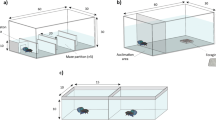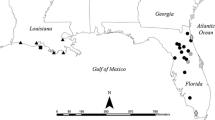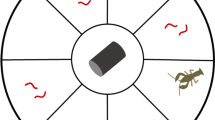Abstract
Identifying the characteristics that determine the success of invasive species has been a major goal of ecology for many decades. Most efforts have focused on life history characteristics of introduced species, environmental tolerances, or on species interactions, such as enemy release. Many of these factors are themselves influenced by more fundamental characteristics such as physiological condition, which in turn is determined in large part by energy intake through foraging activities. Thus, foraging strategy may play a large role in determining the success of invaders. We investigate the contribution of foraging to the success of Hemigrapsus sanguineus, a crab that is native to Asia, but that has invaded the northwest Atlantic and the Mediterranean Sea. We demonstrate four individual foraging patterns of H. sanguineus in its northwest Atlantic invaded range: the presence of seasonal diet shifts, changes in diet with size, individual specialization in diet, and the allocation of current energy intake versus stored energy for reproductive efforts. We highlight how each of these foraging patterns may contribute to the success of this invasive species. Foraging plays a central role in nearly every ecological facet of a species’ ability to survive, reproduce, and thus succeed. We therefore suggest that understanding foraging patterns of introduced species in their new environment can enhance our ability to understand the success or failure of these invasions.





Similar content being viewed by others
References
Adiyodi KG, Adiyodi RG (1970) Endocrine control of reproduction in Decapod Crustacea. Biol Rev Cambridge Philos Soc 45:121–164
Arim M, Abades SR, Laufer G, Loureiro M, Marquet PA (2010) Food web structure and body size: trophic position and resource acquisition. Oikos 119:147–153
Audet D, Miron G, Asu MM (2008) Biological characteristics of a newly established green crab (Carcinus maenas) population in the southern Gulf of St. Lawrence, Canada. J Shellfish Res 27:427–441
Baurdeau P, O’Connor NJ (2003) Predation by the nonindigenous Asian shore crab Hemigrapsus sanguineus on macroalgae and molluscs. Northeastern Natural 10:319–334
Bliss DE (1966) Neurosecretion of invertebrates other than insects. 4. Physiological processes and neurosecretion as related to ecdysis and reproduction—introduction—relation between reproduction and growth in decapod crustaceans. Am Zool 6:231–233
Bolnick DI, Yang LH, Fordyce JA, Davis JM, Svanback R (2002) Measuring individual-level resource specialization. Ecology 83:2936–2941
Bolnick DI, Svanback R, Fordyce JA, Yang LH, Davis JM, Hulsey CD, Forister ML (2003) The ecology of individuals: incidence and implications of individual specialization. Am Nat 161:1–28
Bolnick DI, Amarasekare P, Araújo MS, Bürger R, Levine JM, Novak M, Rudolf VHW, Schreiber SJ, Urban MC, Vasseur DA (2011) Why intraspecific trait variation matters in community ecology. Trends Ecol Evol 26:183–192
Breton G, Faasse M, Noël P, Vincent T (2002) A new alien crab in Europe: Hemigrapsus sanguineus (Decapoda: Brachyura: Grapsidae). J Crustac Biol 22:184–189
Brose U (2010) Body-mass constraints on foraging behaviour determine population and food-web dynamics. Funct Ecol 24:28–34
Brousseau DJ, Baglivo JA (2005) Laboratory investigations of food selection by the Asian shore crab, Hemigrapsus sanguineus: algal versus animal preference. J Crustac Biol 25:130–134
Brousseau DJ, Goldberg R (2007) Effect of predation by the invasive crab Hemigrapsus sanguineus on recruiting barnacles Semibalanus balanoides in western Long Island Sound, USA. Mar Ecol Progress Ser 339:221–228
Brousseau DJ, Baglivo JA, Filipowicz A, Sego L, Alt C (2002) An experimental field study of site fidelity and mobility in the Asian shore crab, Hemigrapsus sanguineus. Northeastern Nat 9:381–390
Brousseau DJ, Kriksciun K, Baglivo JA (2003) Fiddler crab burrow usage by the Asian crab, Hemigrapsus sanguineus, in a Long Island sound salt marsh. Northeastern Nat 10:415–420
Burnham KP, Anderson DR (2002) Model selection and multimodel inference: a practical information-theoretic approach. Springer, New York
Carlton JT (2011) The global dispersal of marine and estuarine crustaceans. In: Galil BS, Clark PF, Carlton JT (eds) In the wrong place–alien marine crustaceans: distribution, biology and impacts. Springer, New York
Caut S, Angulo E, Courchamp F (2008) Dietary shift of an invasive predator: rats, seabirds and sea turtles. J Appl Ecol 45:428–437
Connor MM, White GC (1999) Effects of individual heterogeneity in estimating the persistence of small populations. Nat Resource Model 12:109–127
Crawley MJ (2007) The R book. Wiley, West Sussex
DeGraaf JD, Tyrrell MC (2004) Comparison of the feeding rates of two introduced crab species, Carcinus maenas and Hemigrapsus sanguineus, on the blue mussel, Mytilus edulis. Northeastern Nat 11:163–166
Demeusy N (1962) Rôle de la gland de mue dans l’evolution ovarianne du crabe Carcinus maenas. Linn Can Biol Mar 3:37–56
Depledge MH (1984) Cardiac activity in the intertidal crab Hemigrapsus sanguineus (de Haan). Asian Mar Biol 1:115–123
Devin S, Beisel JN (2007) Biological and ecological characteristics of invasive species: a gammarid study. Biol Invas 9:13–24
Dieckmann U, Doebeli M (1999) On the origin of species by sympatric speciation. Nature 400:354–357
Elton C (1927) Animal ecology. University of Chicago Press, Chicago
Elton C (1958) The ecology of invasions by animals and plants. University of Chicago Press, Chicago
Emlen JM (1966) The role of time and energy in food preference. Am Nat 100:611–617
Feinsinger P, Spears EE, Poole RW (1981) A simple measure of Niche Breadth. Ecology 62:27–32
Fox GA (2005) Extinction risk of heterogeneous populations. Ecology 86:1191–1198
Fox GA, Kendall BE (2002) Demographic stochasticity and the variance reduction effect. Ecology 83:1928–1934
Gerard VA, Cerrato RM, Larson AA (1999) Potential impacts of a western Pacific grapsid crab on intertidal communities of the northwestern Atlantic Ocean. Biol Invas 1:353–361
Griffen BD, Byers JE (2009) Community impacts of two invasive crabs: the roles of density, prey recruitment, and indirect effects. Biol Invas 11:927–940
Griffen BD, Delaney DG (2007) Species invasion shifts the importance of predator dependence. Ecology 88:3012–3021
Griffen BD, Mosblack H (2011) Predicting diet and consumption rate differences between and within species using gut ecomorphology. J Anim Ecol 80:854–863
Griffen BD, Guy T, Buck JC (2008) Inhibition between invasives: a newly introduced predator moderates the impacts of a previously established invasive predator. J Anim Ecol 77:32–40
Griffen BD, Altman I, Hurley J, Mosblack H (2011) Reduced fecundity by one invader in the presence of another: a potential mechanism leading to species replacement. J Exp Mar Biol Ecol 406:6–13
Hardy AC (1924) The herring in relation to its animate environment, part I: the food and feeding habits of the herring with special reference to the coast of England. Fish Invest Lond (Ser 2) 7:1–53
Hayes KR, Sliwa C (2003) Identifying potential marine pests—a deductive approach applied to Australia. Mar Pollut Bull 46:91–98
Kang HK, Poulet SA (2000) Reproductive success in Calanus helgolandicus as a function of diet and egg cannibalism. Mar Ecol Progress Ser 201:241–250
Kendall BE, Fox GA (2002) Variation among individuals and reduced demographic stochasticity. Conserv Biol 16:109–116
Kendall BE, Fox GA (2003) Unstructured individual variation and demographic stochasticity. Conserv Biol 17:1170–1172
Kennish R (1996) Diet composition influences the fitness of the herbivorous crab Grapsus albolineatus. Oecologia 105:22–29
Kennish R (1997) Seasonal patterns of food availability: influences on the reproductive output and body condition of the herbivorous crab Grapsus albolineatus. Oecologia 109:209–218
Kraemer GP, Sellberg M, Gordon A, Main J (2007) Eight-year record of Hemigrapsus sanguineus (Asian shore crab) invasion in western Long Island sound estuary. Northeastern Nat 14:207–224
Leger EA, Rice KJ (2003) Invasive California poppies (Eschscholzia californica Cham.) grow larger than native individuals under reduced competition. Ecol Lett 6:257–264
Lohrer AM, Whitlatch RB (2002) Relative impacts of two exotic brachyuran species on blue mussel populations in Long Island Sound. Mar Ecol Progress Ser 227:135–144
Lohrer AM, Whitlatch RB, Wada K, Fukui Y (2000) Home and away: comparisons of resource utilization by a marine species in native and invaded habitats. Biological Invasions 2:41–57
Lomnicki A (1988) Population ecology of individuals. Princeton University Press, Princeton
Marchetti MP, Moyle PB, Levine R (2004) Invasive species profiling? Exploring the characteristics of non-native fishes across invasion stages in California. Freshw Biol 49:646–661
McDermott JJ (1997) The western Pacific brachyuran (Hemgrapsus sanguineus: Grapsidae), in its new habitat along the Atlantic coast of the United States: geographic distribution and ecology. ICES J Mar Sci 55:289–298
McDermott JJ (1998a) The western Pacific Brachyuran Hemigrapsus sanguineus (Grapsidae) in its new habitat along the Atlantic coast of the United States: feeding, cheliped morphology and growth. Proc Fourth Int Crustacean Congr 4:425–444
McDermott JJ (1998b) The western Pacific brachyuran Hemigrapsus sanguineus (Grapsidae) in its new habitat along the Atlantic coast of the United States: reproduction. J Crustac Biol 18:308–316
Melbourne BA, Hastings A (2008) Extinction risk depends strongly on factors contributing to stochasticity. Nature 454:100–103
O’Connor JD, Gilbert LI (1968) Aspecs of lipid metabolism in crustaceans. Am Zool 8:529–539
Persson A, Hansson LA (1999) Diet shift in fish following competitive release. Can J Fish Aquat Sci 56:70–78
Post DM (2002) Using stable isotopes to estimate trophic position: models, methods, and assumptions. Ecology 83:703–718
Rayner JMV (1985) Linear relations in biomechanics—the statistics of scaling functions. J Zool 206:415–439
Rejmánek M, Richardson DM (1996) What attributes make some plant species more invasive? Ecology 77:1655–1661
Ricciardi A, Rasmussen JB (1998) Predicting the identity and impact of future biological invaders: a priority for aquatic resource management. Can J Fish Aquat Sci 55:1759–1765
Roughgarden J (1972) Evolution of Niche width. Am Nat 106:683–718
Saigusa M, Kawagoye O (1997) Circatidal rhythm of an intertidal crab, Hemigrapsus sanguineus: synchrony with unequal tide height and involvement of a light response mechanisms. Mar Biol 129:87–96
Schoener TW (1968) Anolis Lizards of Bimini—resource partitioning in a complex Fauna. Ecology 49:704
Sibly R (1981) Strategies of digestion and defecation. In: Townsend CR, Calow P (eds) Physiological ecology: an evolutionary approach to resource use. Sinauer Associates, Inc., Sunderland, pp 109–139
Smith JN, Grant PR, Grant BR, Abbot IJ, Abbot LK (1978) Seasonal variation in feeding habits of Darwin’s ground finches. Ecology 59:1137–1150
Snyder WE, Evans EW (2006) Ecological effects of invasive arthropod generalist predators. Annu Rev Ecol Evol Syst 37:95–122
Stephens DW, Krebs JR (1986) Foraging theory. Princeton University Press, Princeton
Stephens DW, Brown JS, Ydenberg RC (2007) Foraging: behavior and ecology. University of Chicago Press, London
Tammaru T, Haukioja E (1996) Capital breeders and income breeders among Lepidoptera—consequences to population dynamics. Oikos 77:561–564
Tyrrell MC, Harris LG (1999) Potential impact of the introduced Asian shore crab, Hemigrapsus sanguineus, in northern New England: diet, feeding preferences, and overlap with the green crab, Carcinus maenas. Mar Bioinvas 1:208–220
Tyrrell MC, Guarino PA, Harris LG (2006) Predatory impacts of two introduced crab species: inferences from microcosms. Northeastern Nat 13:375–390
Veltman CJ, Nee S, Crawley MJ (1996) Correlates of introduction success in exotic New Zealand birds. Am Nat 147:542–557
Vindenes Y, Engen S, Saether BE (2008) Individual heterogeneity in vital parameters and demographic stochasticity. Am Nat 171:455–467
Vonk HJ (1960) Digestion and metabolism. In: Waterman TH (ed) The physiology of crustacea. Academic Press, New York, vol 1, pp 281–316
Williams AB, Mcdermott JJ (1990) An Eastern United-States Record for the Western Indo-Pacific Crab, Hemigrapsus-Sanguineus (Crustacea, Decapoda, Grapsidae). Proc Biol Soc Wash 103:108–109
Wolfe LM (2002) Why alien invaders succeed: support for the escape-from-enemy hypothesis. Am Nat 160:705–711
Acknowledgments
This work was funded by NSF grant number OCE-1129166 and by the University of South Carolina.
Author information
Authors and Affiliations
Corresponding author
Rights and permissions
About this article
Cite this article
Griffen, B.D., Altman, I., Bess, B.M. et al. The role of foraging in the success of invasive Asian shore crabs in New England. Biol Invasions 14, 2545–2558 (2012). https://doi.org/10.1007/s10530-012-0251-8
Received:
Accepted:
Published:
Issue Date:
DOI: https://doi.org/10.1007/s10530-012-0251-8




